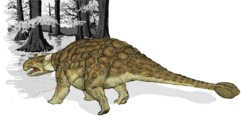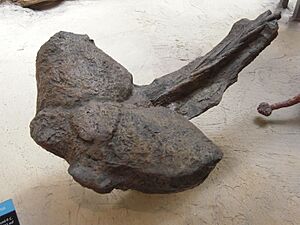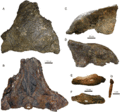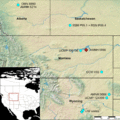Ankylosaurus facts for kids
Ankylosaurus (Ankylosaurus magniventris) was a type of armoured dinosaur. It was the largest of its kind, growing up to 9 metres (30 feet) long. Its name means "fused lizard," which describes its strong, bony armor.
Quick facts for kids AnkylosaurusTemporal range: Upper Cretaceous
80 to 66 mya |
|
|---|---|
 |
|
| Scientific classification | |
| Kingdom: | |
| Class: | |
| Superorder: | |
| Order: | |
| Suborder: | |
| Infraorder: | |
| Family: | |
| Tribe: |
Ankylosaurini
|
| Genus: |
Ankylosaurus
|
| Binomial name | |
| Ankylosaurus magniventris |
|
This dinosaur had a wide, low body covered in tough armor. Meat-eating dinosaurs, called carnivores, would find it very hard to attack Ankylosaurus from above. It could also defend itself using its powerful, club-like tail.
Ankylosaurus was a herbivore, meaning it ate plants. Since there was no grass during the time of the dinosaurs, Ankylosaurus likely ate ferns and low shrubs.
Amazing Armor and Tail Club
The most noticeable thing about Ankylosaurus was its amazing armor. This armor was made of large knobs and plates of bone, called osteoderms or bony scutes. These bony plates were part of its skin.
You can still see osteoderms today in animals like crocodiles, armadillos, and some lizards. The bone armor of Ankylosaurus was probably covered by a very tough, horn-like layer.
These armor plates came in many sizes. Some were wide and flat, while others were small and round. The larger plates were arranged in neat rows along the dinosaur's neck, back, and hips. Many smaller pieces of armor filled in the spaces between the big plates.
Smaller plates might have also covered its legs and tail. The armor of Ankylosaurus was smooth. Its skull was protected by tough, rounded scales. Four large, pyramid-shaped horns stuck out from the back corners of its head.
Underneath its armored belly, Ankylosaurus had normal skin. But a predator would have to flip over this huge animal, which weighed up to 6,000 kg (11,000 lb), to get to its soft underside. Its powerful tail ended in a heavy, bony club. This club was a strong weapon that Ankylosaurus could swing to protect itself from attackers.
Images for kids
-
Skull of holotype AMNH 5895 and reconstruction diagram of same
-
1908 skeletal reconstruction of the holotype, with missing parts restored after Stegosaurus
-
Replica of the 1964 World's Fair Ankylosaurus (note spikes and dragging tail), Royal Alberta Museum
-
Cervical half ring from the neck of Euoplocephalus (A–B) compared with half-ring fragments (C–J) of Ankylosaurus (holotype), and possible back osteoderms (K–L)
-
Only known tail club (AMNH 5214), American Museum of Natural History
-
Skull of specimen CMN 8880, the largest-known ankylosaurid, including lower jaw (E–F) and tooth (G)
-
Back vertebra with fused ribs of the holotype. The broad body housed a large digestion system.
See also
 In Spanish: Ankylosaurus magniventris para niños
In Spanish: Ankylosaurus magniventris para niños
















